Enhancing Clay Soil’s Geotechnical Properties Utilizing Sintered Gypsum and Glass Powder
Abstract
:1. Introduction
2. Experiment Program
2.1. Materials
2.1.1. Clay Soil
2.1.2. Glass Powder
2.1.3. Sintered Gypsum
2.2. Method
2.2.1. Molding Specimens and Curing Procedure
2.2.2. Unconfined Compressive Strength (UCS)
2.2.3. Ultrasonic Pulse-Velocity Tests
2.2.4. Durability Test (Wetting–Drying Cycles)
2.2.5. Microstructural Tests
3. Results and Analysis
3.1. Impact of Test Variables on Strength and Stiffness
3.2. Influence of Porosity–Binder Index on UCS
3.3. Influence of P/B Index on G0
3.4. Influence of P/B Index on Normalized UCS and G0
3.5. Relations between Strength and Stiffness
3.6. Durability Assessment of Soil Samples by Sintered Gypsum and Glass Powder
3.7. Microstructural Analysis
4. Conclusions
- The results showed strong relationships between the test variables and the samples’ strength and stiffness. The strength and stiffness of the clay specimens were continuously enhanced by increased density and gypsum content, which is notable. Conversely, the influence of glass-powder content exhibited a non-uniform behavior, where the addition of 12% GP emerged as a critical threshold, revealing an unexpected shift in the trend toward improved strength and stiffness features compared to lower GP percentages;
- The study also found a strong link between the P/B index and UCS and G0. Normalization of the data enhanced the predictability of these properties, yielding valuable equations for predicting qu and G0 for specific clay blends and facilitating efficient material design and assessment. Additionally, the durability assessment revealed that low GP content aggravated the durability factor of the specimens. The worst GP content for durability was 4%, while an increase to 12% GP led to a slight decrease in porosity and improved durability. The generated equation for the ALM proved to be an accurate tool for predicting the ALM for varying additive contents;
- Microstructural analyses via SEM and XRD clarified critical insights into the pozzolanic reactions induced by GP and sintered gypsum. SEM microphotographs unveiled the formation of ettringite, C-A-H, and C-S-H compounds, contributing significantly to enhanced strength, stiffness, and erosion resistance in the treated samples. Moreover, microstructural analyses highlighted the pronounced impact of the curing duration on the soil’s structure, explaining its significant influence on mechanical behavior.
Author Contributions
Funding
Informed Consent Statement
Data Availability Statement
Acknowledgments
Conflicts of Interest
References
- Shin, J.; Park, J.; Park, N. A method to recycle silicon wafers from end-of-life photovoltaic modules and solar panels by using recycled silicon wafers. Sol. Energy Mater. Sol. Cells 2017, 162, 1–6. [Google Scholar] [CrossRef]
- Ardente, F.; Latunussa, C.E.L.; Blengini, G.A. Resource-efficient recovery of critical and precious metals from waste silicon PV panel recycling. Waste Manag. 2019, 91, 156–167. [Google Scholar] [CrossRef] [PubMed]
- Irena, I.P. End-of-Life Management: Solar Photovoltaic Panels; International Renewable Energy Agency: Masdar City, United Arab Emirates; International Energy Agency Photovoltaic Power Systems: Redfern, Australia, 2016. [Google Scholar]
- Mahmoudi, S.; Huda, N.; Alavi, Z.; Behnia, M. Material flow analysis of the end-of-life photovoltaic waste in Australia. DEStech Trans. Environ. Energy Earth Sci. 2018. [Google Scholar] [CrossRef] [PubMed]
- Fthenakis, V.M. Life cycle impact analysis of cadmium in CdTe PV production. Renew. Sustain. Energy Rev. 2004, 8, 303–334. [Google Scholar] [CrossRef]
- Fthenakis, V.M.; Moskowitz, P.D. Photovoltaics: Environmental, health and safety issues and perspectives. Prog. Photovolt. 2000, 8, 27–38. [Google Scholar] [CrossRef]
- Nieuwlaar, E.; Alsema, E.; Van Engelenburg, B. Using life-cycle assessments for the environmental evaluation of greenhouse gas mitigation options. Energy Convers. Manag. 1996, 37, 831–836. [Google Scholar] [CrossRef]
- Phylipsen, G.J.M.; Alsema, E.A. Environmental Life-Cycle Assessment of Multicrystalline Silicon Solar Cell Modules. Ph.D. Thesis, Department of Science, Technology and Society, Utrecht University, Utrecht, The Netherlands, 1995. [Google Scholar]
- Bang, Y.Y.; Hong, N.J.; Sung Lee, D.; Lim, S.R. Comparative assessment of solar photovoltaic panels based on metal-derived hazardous waste, resource depletion, and toxicity potentials. Int. J. Green Energy 2018, 15, 550–557. [Google Scholar] [CrossRef]
- Padoan, F.C.; Altimari, P.; Pagnanelli, F. Recycling of end of life photovoltaic panels: A chemical perspective on process development. Sol. Energy 2019, 177, 746–761. [Google Scholar] [CrossRef]
- Mahmoudi, S.; Huda, N.; Behnia, M. Critical assessment of renewable energy waste generation in OECD countries: Decommissioned PV panels. Resour. Conserv. Recycl. 2021, 164, 105145. [Google Scholar] [CrossRef]
- Li, G.; Zhu, R.; Yang, Y. Polymer solar cells. Nat. Photonics 2012, 6, 153–161. [Google Scholar] [CrossRef]
- Shen, P.; Bin, H.J.; Xiao, L.; Li, Y.F. Enhancing the photovoltaic performance of copolymers containing thiophene unit with D-A conjugated side chain by rational molecular design. Macromolecules 2013, 46, 9575–9586. [Google Scholar] [CrossRef]
- Kuttah, D.; Sato, K. Review on the effect of gypsum content on soil behavior. Transp. Geotech. 2015, 4, 28–37. [Google Scholar] [CrossRef]
- Saidate, I.; Rikioui, T. Stabilization of gypsum clay soil by adding lime. Civ. Eng. J. 2022, 8, 2511–2520. [Google Scholar] [CrossRef]
- Rai, A.K.; Singh, G.; Tiwari, A.K. Comparative study of soil stabilization with glass powder, plastic and e-waste: A review. Mater. Today Proc. 2020, 32, 771–776. [Google Scholar] [CrossRef]
- Tahmoorian, F.; Samali, B.; Yeaman, J.; Mirzababaei, M. Evaluation of the volumetric performance of asphalt mixtures containing recycled construction aggregate (rca). Int. J. Pavement Eng. 2022, 23, 2191–2205. [Google Scholar] [CrossRef]
- Gowtham, S.; Naveenkumar, A.; Ranjithkumar, R.; Vijayakumar, P.; Sivaraja, M. Stabilization of clay soil by using glass and plastic waste powder. Int. J. Eng. Tech. 2018, 4, 146–150. [Google Scholar]
- Khan, M.S.; Tufail, M.; Mateeullah, M. Effects of Waste Glass Powder on the Geotechnical Properties of Loose Subsoils. Civ. Eng. J. 2018, 4, 2044–2051. [Google Scholar] [CrossRef]
- Parihar, N.S.; Garlapati, V.K.; Ganguly, R. Stabilization of Black Cotton Soil Using Waste Glass. In Handbook of Environmental Materials Management; Hussain, C.M., Ed.; Springer International Publishing: Berlin/Heidelberg, Germany, 2018; pp. 1–16. [Google Scholar]
- Pourabbas Bilondi, M.; Toufigh, M.M.; Toufigh, V. Experimental Investigation of Using a Recycled Glass Powder-based Geopolymer to Improve the Mechanical Behavior of Clay Soils. Constr. Build. Mater. 2018, 170, 302–313. [Google Scholar] [CrossRef]
- Abhishek; Sharma, R.K.; Bhardwaj, A. Effect of Construction Demolition and Glass Waste on Stabilization of Clayey Soil. In Handbook of Environmental Materials Management; Hussain, C.M., Ed.; Springer International Publishing: Berlin/Heidelberg, Germany, 2019; pp. 87–94. [Google Scholar]
- Arrieta Baldovino, J.D.J.; dos Santos Izzo, R.L.; da Silva, É.R.; Lundgren Rose, J. Sustainable use of recycled-glass powder in soil stabilization. J. Mater. Civ. Eng. 2020, 32, 04020080. [Google Scholar] [CrossRef]
- Canakci, H.; Aram, A.L.; Celik, F. Stabilization of clay with waste soda lime glass powder. Procedia Eng. 2016, 161, 600–605. [Google Scholar] [CrossRef]
- Hassnawi, A.; Mahdi, Z.A.; Noor, S. Assessment of subgrade soil. Int. J. Civ. Eng. Technol. 2018, 9, 12–21. [Google Scholar]
- Babatunde, O.; Sani, J.; Sambo, S. Black cotton soil stabilization using glass powder. Int. J. Innov. Res. Sci. Eng. Technol. 2019, 8, 5208–5214. [Google Scholar]
- Al-Taie, A.; Yaghoubi, E.; Wasantha, P.L.P.; Van Staden, R.; Guerrieri, M.; Fragomeni, S. Mechanical and physical properties and cyclic swell-shrink behaviour of expansive clay improved by the recycled glass. Int. J. Pavement Eng. 2023, 24, 2204436. [Google Scholar] [CrossRef]
- Ibrahim, H.H.; Mawlood, Y.I.; Alshkane, Y.M. Using waste glass powder for stabilizing high-plasticity clay in Erbil city-Iraq. Int. J. Geotech. Eng. 2021, 15, 496–503. [Google Scholar] [CrossRef]
- ASTM D4318-17e1; Standard Test Methods for Liquid Limit, Plastic Limit, and Plasticity Index of Soils. ASTM International: West Conshohocken, PA, USA, 2017. [CrossRef]
- ASTM D854-14; Standard Test Methods for Specific Gravity of Soil Solids by Water Pycnometer. ASTM International: West Conshohocken, PA, USA, 2014. [CrossRef]
- ASTM D6913/D6913M-17; Standard Test Methods for Particle-Size Distribution (Gradation) of Soils Using Sieve Analysis. ASTM International: West Conshohocken, PA, USA, 2017. [CrossRef]
- ASTM D698-12e2; Standard Test Methods for Laboratory Compaction Characteristics of Soil Using Standard Effort (12,400 ft lbf/ft3 (600 kN-m/m3)). ASTM International: West Conshohocken, PA, USA, 2012. [CrossRef]
- ASTM C39/C39M-20; Standard Test Method for Compressive Strength of Cylindrical Concrete Specimens. ASTM International: West Conshohocken, PA, USA, 2020. [CrossRef]
- Selig, E.; Ladd, R. Preparing Test Specimens Using Undercompaction. Geotech. Test. J. 1978, 1, 16. [Google Scholar] [CrossRef]
- ASTM C511-19; Standard Specification for Mixing Rooms, Moist Cabinets, Moist Rooms, and Water Storage Tanks Used in the Testing of Hydraulic Cements and Concretes. ASTM International: West Conshohocken, PA, USA, 2019. [CrossRef]
- ASTM D1632_D1632M-07; Standard Test Methods for Compressive Strength of Molded Soil-Cement Cylinders. ASTM International: West Conshohocken, PA, USA, 2007. [CrossRef]
- ASTM D1633-17; Standard Test Methods for Compressive Strength of Molded Soil-Cement Cylinders. ASTM International: West Conshohocken, PA, USA, 2017. [CrossRef]
- Consoli, N.C.; Festugato, L.; Filho, H.C.S.; Miguel, G.D.; Neto, A.T.; Andreghetto, D. Durability assessment of soil-pozzolan-lime blends through ultrasonic-pulse velocity test. J. Mater. Civ. Eng. 2020, 32, 04020223. [Google Scholar] [CrossRef]
- ASTM D559; Standard Test Methods for Wetting and Drying Compacted Soil-Cement Mixtures. ASTM International: West Conshohocken, PA, USA, 2015. [CrossRef]
- Consoli, N.C.; Marques, S.F.V.; Floss, M.F.; Festugato, L. Broad-spectrum empirical correlation determining tensile and compressive strength of cement-bonded clean granular soils. J. Mater. Civ. Eng. 2017, 29, 06017004. [Google Scholar] [CrossRef]
- Filho, H.C.S.; Martins, C.G.; Menezes, R.J.W.; Dornelles, L.E.; Consoli, N.C. The effect of key parameters on the strength of a dispersive soil stabilized with sustainable binders. Geotech. Geol. Eng. 2021, 39, 5395–5404. [Google Scholar] [CrossRef]
- Hanafi, M.; Abki, A.; Ekinci, A.; Baldovino, J.D.J.A. Mechanical properties of alluvium clay treated with cement and carbon fiber: Relationships among strength, stiffness, and durability. Int. J. Pavement Eng. 2022, 24, 2094928. [Google Scholar] [CrossRef]
- Consoli, N.C.; Foppa, D.; Festugato, L.; Heineck, K.S. Key parameters for strength control of artificially cemented soils. J. Geotech. Geoenviron. Eng. 2007, 133, 197–205. [Google Scholar] [CrossRef]
- Ekinci, A.; Filho, H.C.S.; Consoli, N.C. Copper slag-hydrated lime portland cement stabilized marine deposited clay. Proc. Inst. Civ. Eng. Improv. 2019, 175, 1–30. [Google Scholar]
- Ekinci, A.; Hanafi, M.; Aydin, E. Strength, stiffness, and microstructure of wood-ash stabilized marine clay. Minerals 2020, 10, 796. [Google Scholar] [CrossRef]
- Wu, Z.; Deng, Y.; Liu, S.; Liu, Q.; Chen, Y.; Zha, F. Strength and micro-structure evolution of compacted soils modified by admixtures of cement and metakaolin. Appl. Clay Sci. 2016, 127, 44–51. [Google Scholar] [CrossRef]


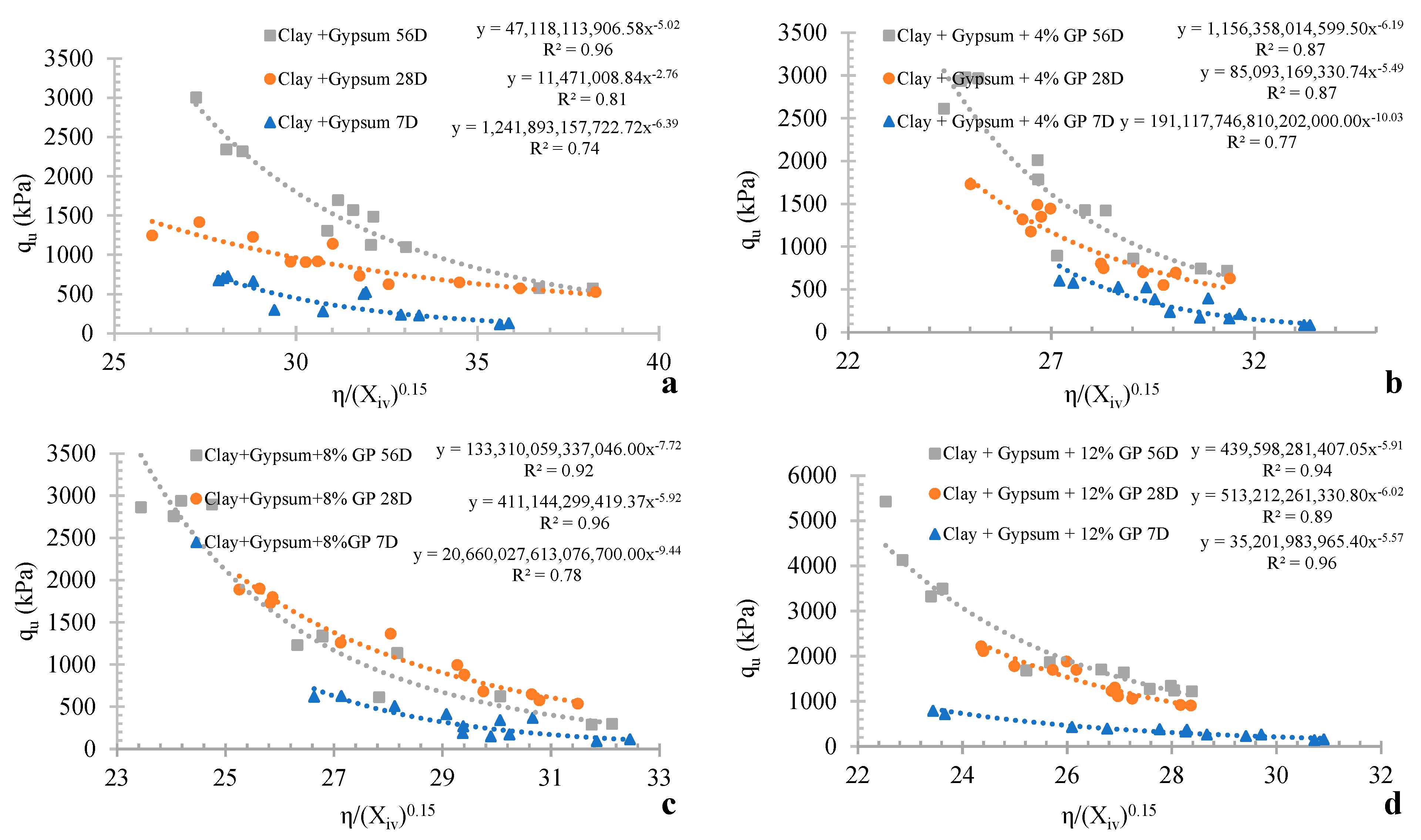

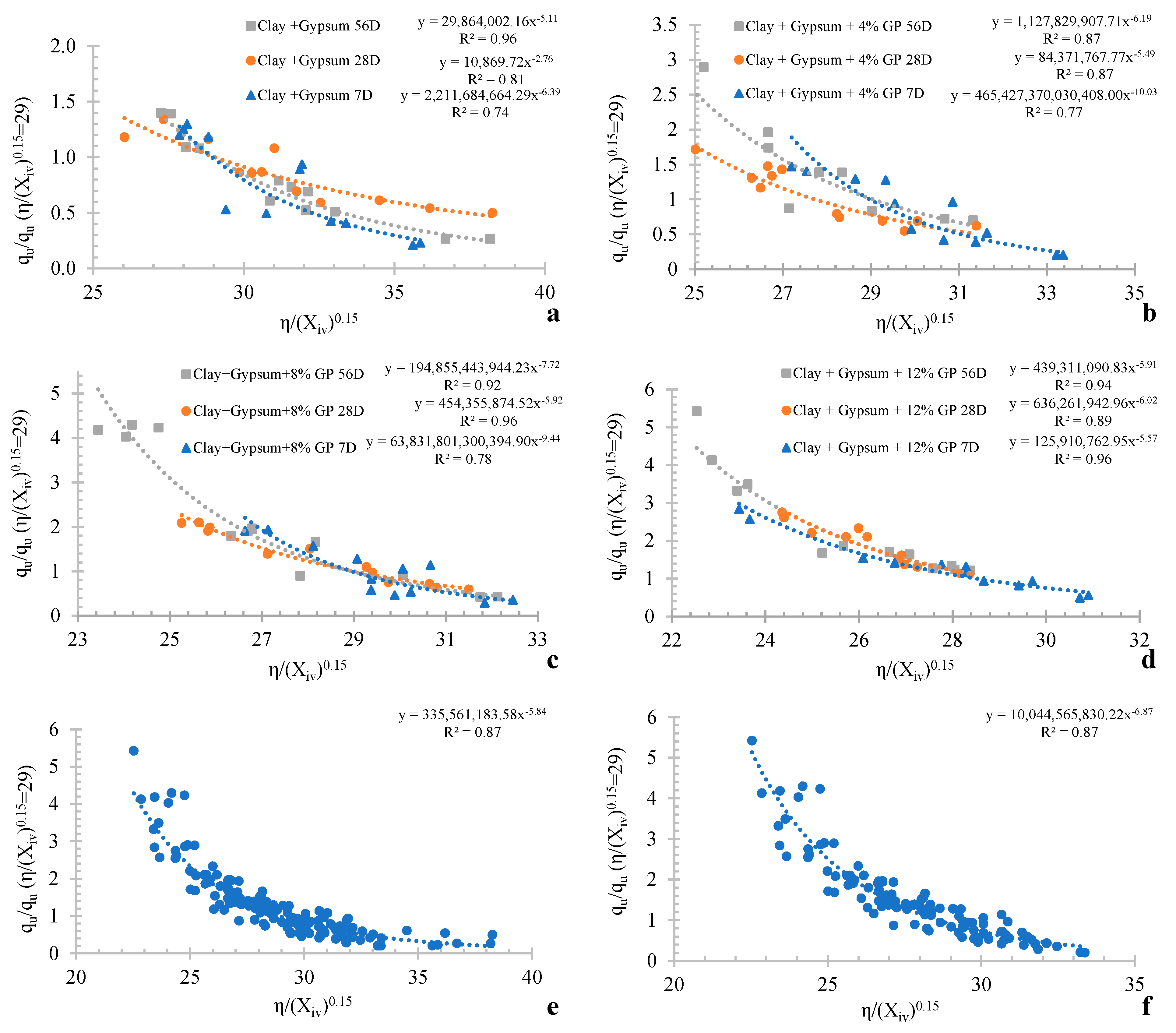


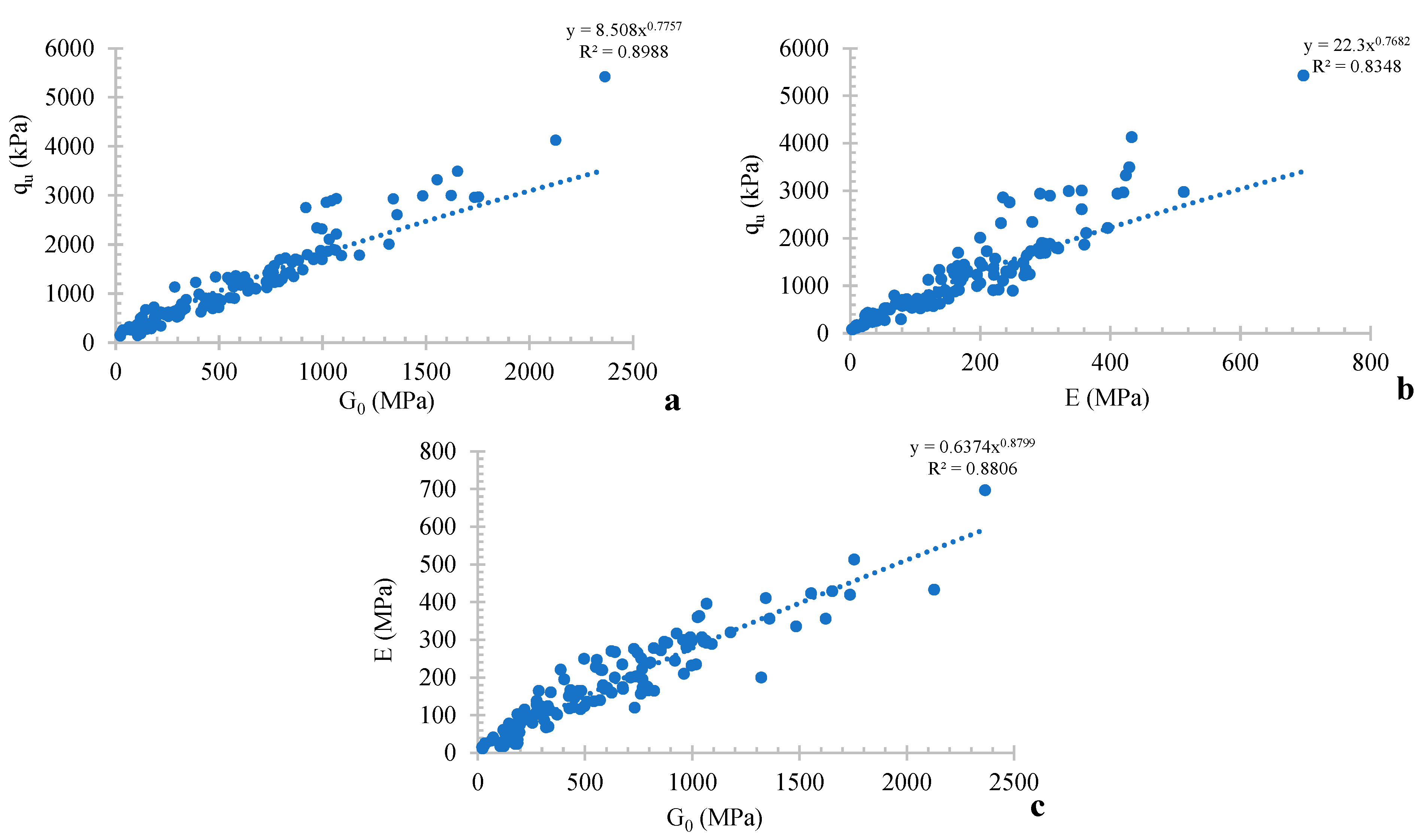


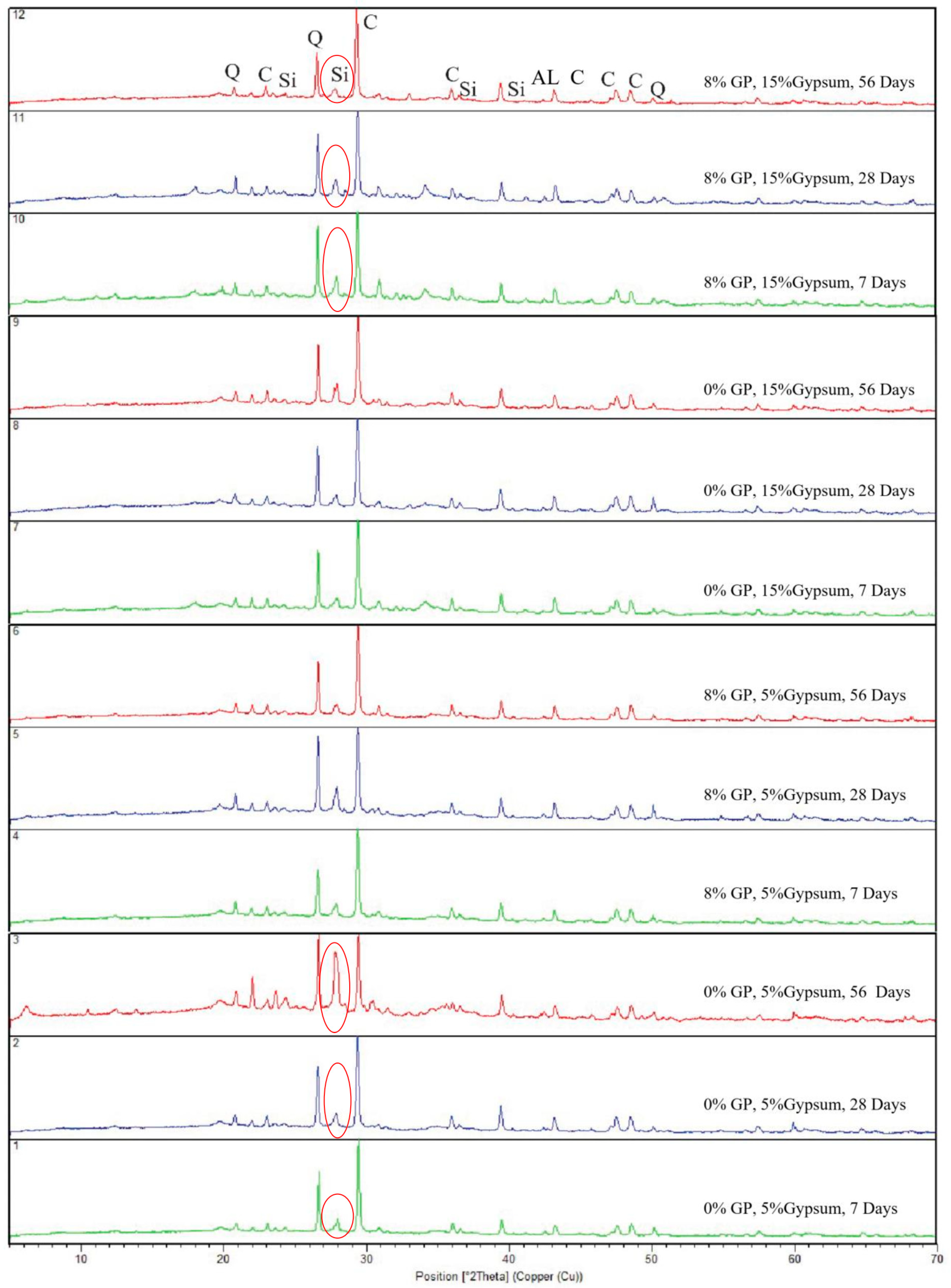
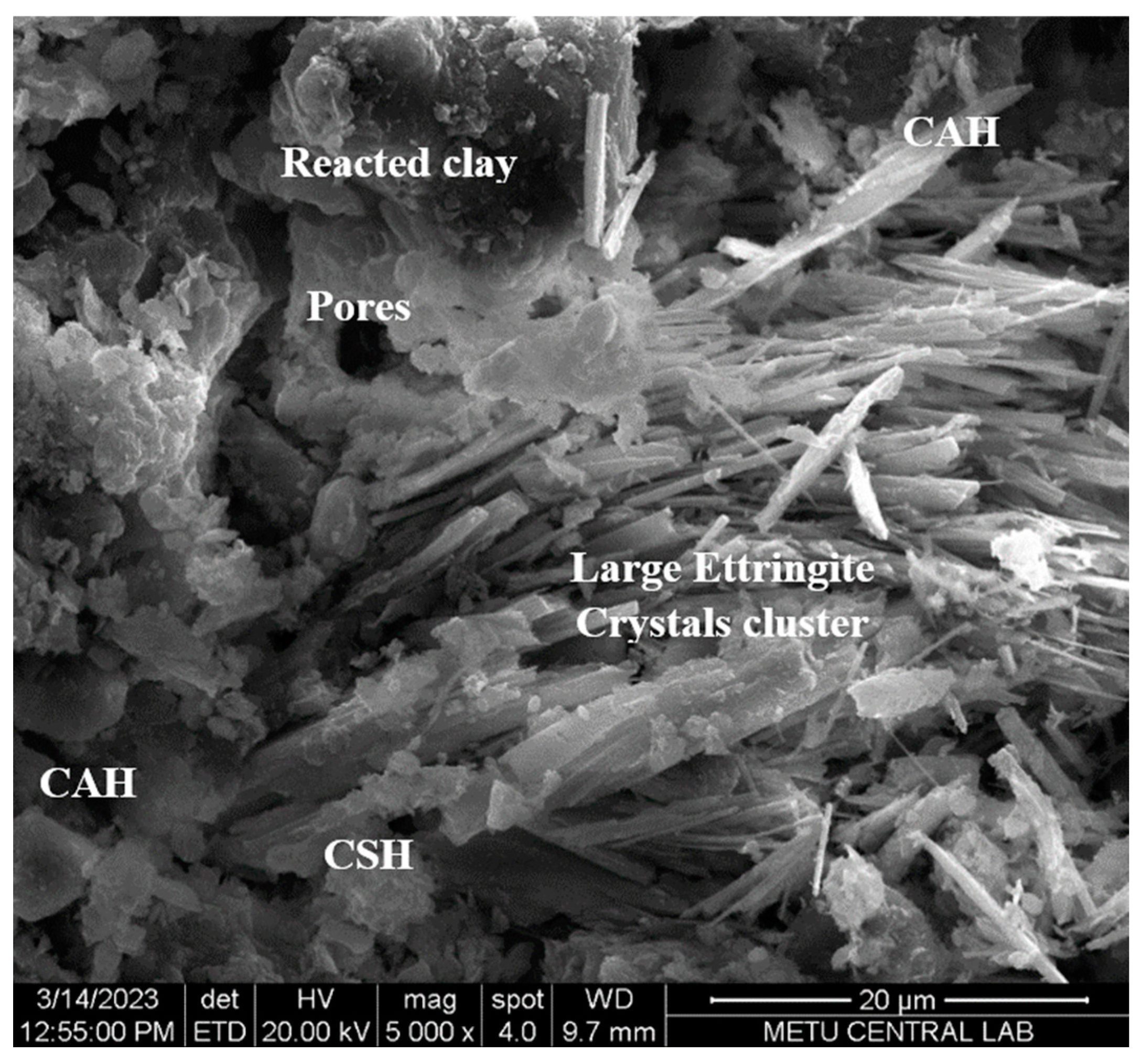
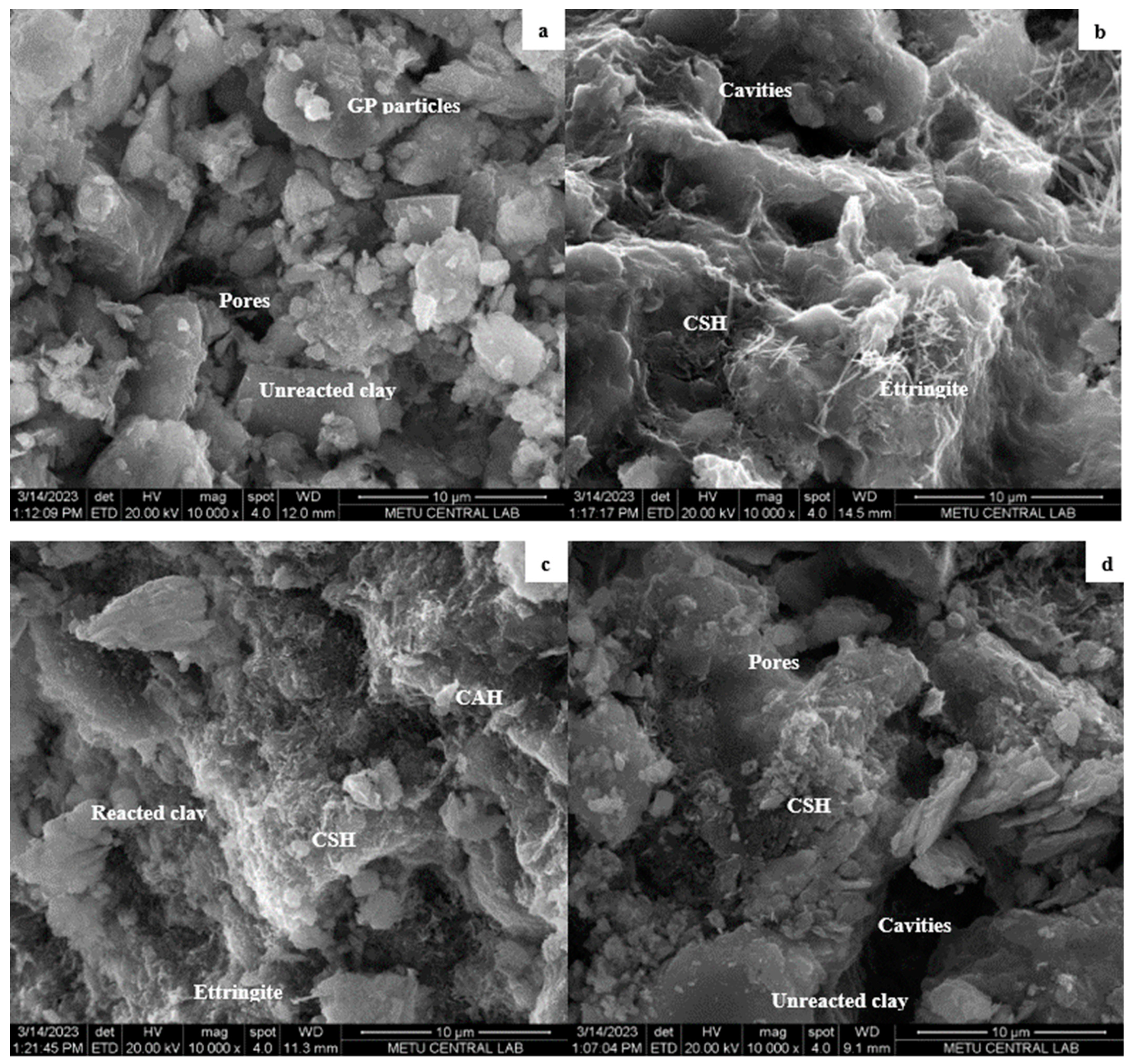

| Properties | Clay | Sintered Gypsum Powder | Glass Powder |
|---|---|---|---|
| Consistency Limits (ASTM D4318-17e1) [29] | |||
| Plasticity index (%) | 26 | - | - |
| Liquid limit (%) | 46 | - | - |
| Specific gravity (ASTM D854-14) [30] | 2.66 | 2.33 | 2.64 |
| Particle-Size Distribution (ASTM D6913/D6913M-17 [31] | |||
| D50 (mm) | 0.005 | 0.1 | 1 |
| Clay (diameter < 0.002 mm) (%) | 40 | - | - |
| Silt (0.002 mm < diameter < 0.075 mm) (%) | 54 | 25 | 2.53 |
| Fine sand (0.075 mm < diameter < 0.425 mm) (%) | 6 | 75 | 25 |
| Standard Compaction Characteristics (ASTM D698-12e2) [32] | |||
| Maximum Dry Density (kg/m3) | 1700 | - | - |
| Optimum moisture Content (%) | 17 | - | - |
Disclaimer/Publisher’s Note: The statements, opinions and data contained in all publications are solely those of the individual author(s) and contributor(s) and not of MDPI and/or the editor(s). MDPI and/or the editor(s) disclaim responsibility for any injury to people or property resulting from any ideas, methods, instructions or products referred to in the content. |
© 2024 by the authors. Licensee MDPI, Basel, Switzerland. This article is an open access article distributed under the terms and conditions of the Creative Commons Attribution (CC BY) license (https://creativecommons.org/licenses/by/4.0/).
Share and Cite
Nategh, M.; Ekinci, A.; Iravanian, A.; Fahrioğlu, M. Enhancing Clay Soil’s Geotechnical Properties Utilizing Sintered Gypsum and Glass Powder. Appl. Sci. 2024, 14, 4961. https://doi.org/10.3390/app14124961
Nategh M, Ekinci A, Iravanian A, Fahrioğlu M. Enhancing Clay Soil’s Geotechnical Properties Utilizing Sintered Gypsum and Glass Powder. Applied Sciences. 2024; 14(12):4961. https://doi.org/10.3390/app14124961
Chicago/Turabian StyleNategh, Mehrdad, Abdullah Ekinci, Anoosheh Iravanian, and Murat Fahrioğlu. 2024. "Enhancing Clay Soil’s Geotechnical Properties Utilizing Sintered Gypsum and Glass Powder" Applied Sciences 14, no. 12: 4961. https://doi.org/10.3390/app14124961






